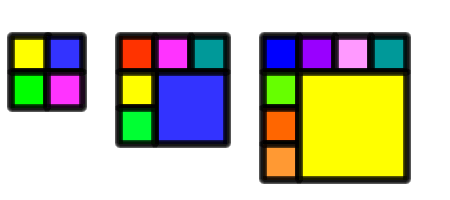Squares, squares and more squares
Can you dissect a square into: 4, 7, 10, 13... other squares? 6, 9,
12, 15... other squares? 8, 11, 14... other squares?
Problem
Image

The diagram shows a square
dissected into seven smaller squares.
Can a square be dissected into any
number of squares?
Can you dissect a square into: two,
three, four, five ... $n$ other squares?
Can you justify your findings?
Getting Started
Can you dissect a square into:
$4, 7, 10, 13\ldots$ other squares?
$6, 9, 12, 15 \ldots$other squares?
$8, 11, 14 \ldots$other squares?
Student Solutions
Sarah sent us her answer to this problem:
Once we've got some number of squares, say n, we can get n+3, by subdividing one of the squares into 4. So if we can get 4, 6 and 8 squares, then we can also get 7, 10, 13, ..., 9, 12, 15, ... and 8, 11, 14, ... squares, that is, we can get 4, 6, 7, 8, 9, 10, 11, 12, and in fact everything above this.
Here's how we can get 4, 6, and 8 squares.
Image

William noticed that you can't make 2, 3 or 5 squares. Here's his explanation for why not:
For 2 or 3 squares, you'd have to have a small square with at least two of its corners at the corners of the big square. But then it would be the same size as the big square, so we'd only use 1 square. For five squares, you'd have to have a different square in each corner (for the reason just explained). But if you think about it you see that if you're going to have more than four squares, then you actually need at least six, so you can't do it with 5.
